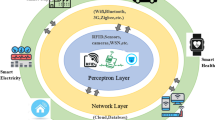Abstract
The vehicular ad hoc network (VANET) is a promising technology that can provide Internet access services for vehicles. With the development of VANET, tremendous intelligent vehicles will emerge mass and different communication requirements. Software-defined networking (SDN) is regarded as a potential technology to enhance network performance. In recent years, a new networking paradigm called software defined vehicular networks (SDVN) has been proposed. Nevertheless, the security issues still need to be considered for SDVN, because malicious vehicles can put forward fake requirements on the control plane of SDVN, which deteriorates the network performance in a certain degree. In this paper, we associate resources allocation problem with trust value of vehicles for the first time. The trust value of vehicles can be obtained through trust management system. Considering that there are many defects in the state-in-art trust management schemes, in this paper, a decentralized trust management architecture is designed which constitutes of three layers based on consortium blockchain. A joint proof-of-stake and modified practical Byzantine fault tolerance (PoS-mPBFT) algorithm is proposed to the shorten the confirmation time, which is deployed on RSUs. Different from previous researches that focus on designing methods to evaluate trust value, we use prediction model to estimate trust value of vehicles in the next period. After calculating trust value of vehicles, it assigns more resources to those high credibility vehicles when SDN services are provided. Meanwhile, to increase the efficiency of resource allocation, we convert the multiple-path mapping problem of the virtual network into the multi-commodity flow problem, which is solved by a heuristic algorithm. The simulation results indicate that the proposed trust management architecture and heuristic algorithm could provide better safety in SDVN and shorten consensus time, meanwhile effectively abstract underlying resources to enhance network load balance and capacity.








Similar content being viewed by others
References
Chen C, Wang Z, Guo B (2016) The road to the chinese smart city: progress, challenges, and future directions. IT PROF 18(1):14–17
Nunes BA, Mendonca M, Nguyen X, Obraczka K, Turletti T (2014) A survey of software-defined networking: past, present, and future of programmable networks. IEEE Commun Surveys Tuts 16(3):1617–1634
He Z, Cao J, Liu X (2016) SDVN: Enabling rapid network innovation for heterogeneous vehicular communication. IEEE Netw 30(4):10–15
Ozcevik ME, Canberk B, Duong TQ (2017) End to end delay modeling of heterogeneous traffic flows in software defined 5G networks. Ad Hoc Netw 60:26–39
Li H, Dong M, Ota K (2016) Control plane optimization in software-defined vehicular ad hoc networks. IEEE Trans Veh Technol 65(10):7895–7904
Yaqoon Y, Ahmad I, Ahmed E, Gani A, Imran M, Guizani N (2017) Overcoming the key challenges to establishing vehicular communication: is SDN the answer? IEEE Commun Mag 55(7):128–134
Mahmoud ME, Shen X (2011) An integrated stimulation and punishment mechanism for thwarting packet dropping attack in multihop wireless networks. IEEE Trans Veh Technol 60(8):3947–3962
Li Z, Chi G, Tricia C (2014) On joint privacy and reputation assurance for vehicular ad hoc networks. IEEE Trans Mobile Comput 13(10):2334–2344
Huang X, Yu R, Kang J, Zhang Y (2017) Distributed reputation management for secure and efficient vehicular edge computing and networks. IEEE Access 5:25408–25420
Zheng Q, Zheng K, Zhang H, Leung VC (2016) Delay-optimal virtualized radio resource scheduling in software-defined vehicular networks via stochastic learning. IEEE Trans Veh Technol 65(10):7857–7867
Zhu Y, Ammmar M (2006) Algorithms for assigning substrate network resources to virtual network components. In: 25th IEEE international conference on computer communications (INFOCOM), pp 1–12
Lai C, Zhang K, Cheng N, Li H, Shen X (2017) SIRC: A secure incentive scheme for reliable cooperative downloading in highway VANETs. IEEE Trans Intell Transport Syst 18(6):1559–1574
Li Q, Malip A, Martin KM, Ng S, Zhang J (2012) A reputation-based announcement scheme for VANETs. IEEE Trans Veh Technol 61(9):4095–4108
Raya M, Papadimitratos P, Gligor VD, Hubaux J (2008) On data-centric trust establishment in ephemeral ad hoc networks. In: IEEE 27th conference on computer communications (INFOCOM), pp 1238–1246
Yang Z, Yang K, Lei L, Zheng K, Leung VC (2018) Blockchain-based decentralized trust management in vehicular networks. IEEE Internet of Things Journal early access
Secinti G, Canberk B, Duong TQ, Shu L (2017) Software defined architecture for VANET: a testbed implementation with wireless access management. IEEE Commun Mag 55(7):135–141
Muzio JC, Rosenerg IC (1986) Introduction—multiple-valued logic. IEEE Trans Comput C-35(2):97–98
Nakamoto S (2008) https://bitcoin.org/bitcoin.pdf
Castro M, Liskov B (1999) Practical byzantine fault tolerance. In: Third symposium on operating systems design and implementation (OSDI)
Gonzlez A, Barra E, Beghelli A, Leiva A (2015) A sub-graph mapping-based algorithm for virtual network allocation over flexible grid networks. In: IEEE 17th International Conference on Transparent Optical Networks (ICTON), pp 1–4
Jiang M, Wang B, Wu M (2011) Research on network virtualization and virtual network mapping algorithm. Chin J Electron 39(6):1315–1320
Martin-Vega FJ, Aguayo-Torres MC, Gomez G, Entrambasaguas JT, Duong TQ (2018) Key technologies, modeling approaches, and challenges for millimeter-wave vehicular communications. IEEE Communication Magazine 56(10):28 C 35
Author information
Authors and Affiliations
Corresponding author
Additional information
Publisher’s Note
Springer Nature remains neutral with regard to jurisdictional claims in published maps and institutional affiliations.
Rights and permissions
About this article
Cite this article
Zhao, N., Wu, H. & Zhao, X. Consortium Blockchain-Based Secure Software Defined Vehicular Network. Mobile Netw Appl 25, 314–327 (2020). https://doi.org/10.1007/s11036-019-01285-9
Published:
Issue Date:
DOI: https://doi.org/10.1007/s11036-019-01285-9




